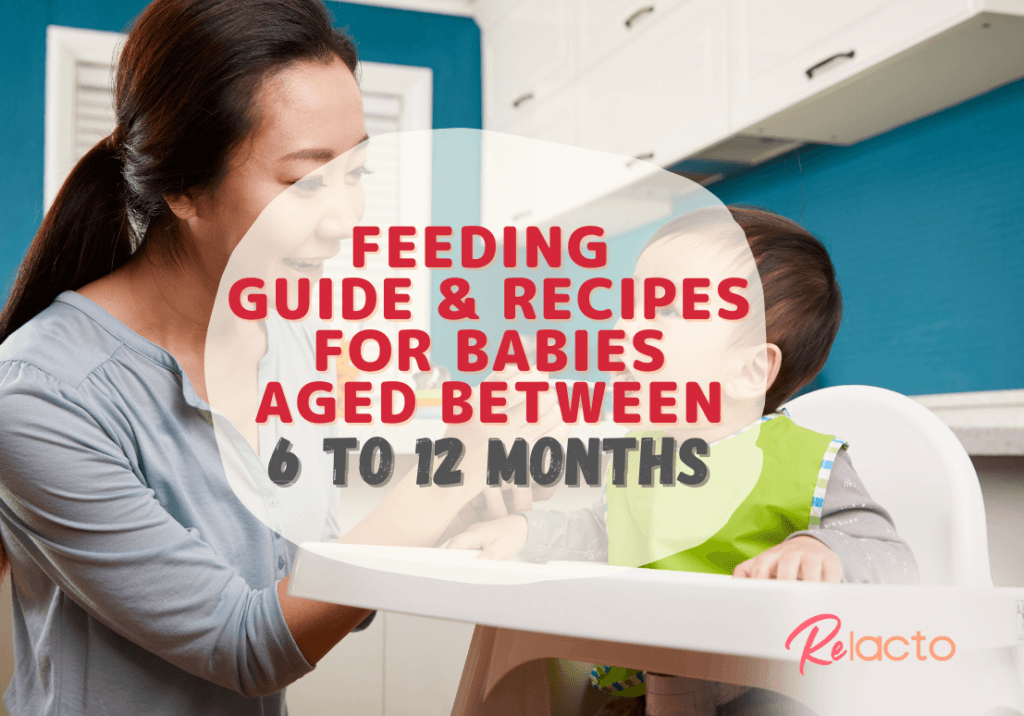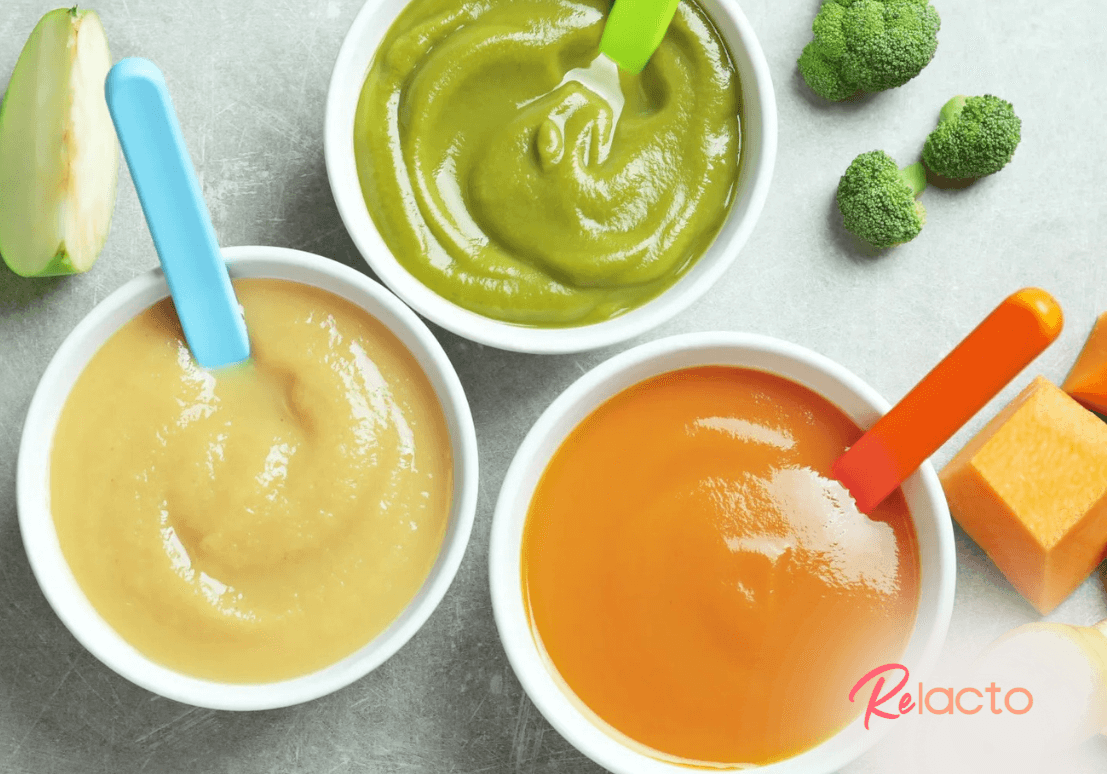Feeding Guide For Babies Aged Between 6 to 12 months

Generally, babies can start having solid food when they are around 6 months old. As they have been only having milk so far, it is a gradual process and you must be able to read if your baby is ready for it. Rushing into feeding too quickly may pose problems as babies are not ready to start chewing before 6 months. This could cause food to get stuck in their airways and them choking. In addition, their digestive system is still developing, so weaning too early on may lead to digestive issues and stomach aches.
How to know when your baby is ready to wean?
While it is recommended for mothers to breastfeed exclusively for 6 months, there are reasons as to why mothers choose to wean their babies early, such as breastfeeding difficulty or low milk supply. Health organisations actually recommend breastfeeding between 1-2 years, and even more. However, the decision ultimately remains yours.
If you are unsure if your baby is ready to wean, or just want your baby to have the best of both worlds, here are 6 ways you can tell.
- Baby is able to sit upright on his or her own. Being able to do so indicates that your baby is developing core strength and fine motor skills that eating requires.
- Babies start to explore things with their mouths, always reaching for things or food and bringing them to their mouths. This could be the start of the teething stage.
- Baby expressing more interest in food. You might notice your baby’s eyes readily following the spoon or your baby eagerly opening his or her mouth as you bring the spoon to your or your baby’s mouth.
- Babies do not really push with their tongues, reduced tongue thrust reflex. Meaning they will be able to accept food more easily without you needing to urge or push it in.
- Baby is able to raise his or her head and has good neck control too. Although this seemingly relates to the first point, this sign tends to happen before it. So, if your baby is able to do this well, you both are on the right path to weaning.
- Baby is able to physically eat. This would mean that your baby has developed mouth muscles that are ready for safe and proper feeding. See if your baby is able to somewhat close his or her mouth over a spoon, hold the food in the mouth, and swallow it.
Say your baby does exhibit all those signs and you’re looking to how you can go about the weaning process. There are two main styles of weaning which you can opt for depending on your preference.
i. Puree

A conventional practice of weaning, feeding pureed food to babies has been the norm for a long time. Usually, babies are given a try at this with single vegetables or fruit, or baby rice mixed with breast milk or formula at small amounts. Once they get used to it, more textured food is introduced to their diets like mashed food, minced and finger food.
Eventually, babies could be given a spoon to allow self-feeding once they are able to chew and swallow lumpy or more solid foods. This could also help develop their hand-eye coordination aside from learning how to feed themselves.
ii. Baby-led weaning (BLW)
Baby-led weaning, or auto-weaning, is an approach that is gaining traction which encourages the introduction of solids to babies at 6 months of age. This is different from the traditional puree method in the sense that babies are given finger foods – soft pieces of food – and allowed to feed themselves without a spoon right from the get go. Research shows that this method promotes a “responsive eating style” where the baby is in control of what, when, and how much they eat. This aids with the baby’s response to hunger and fullness.
That being said, it is rumoured that this style of weaning could lead to BLW babies being underweight as opposed to those who go with the puree method, while also lacking certain nutrients especially iron. However, there is inconclusive research to this as there is insufficient evidence.
Whichever method you choose, here are some mistakes to avoid:
Only feeding “healthy foods” which are only vegetables and fruits.
Many parents have good intentions and really want their kids to start with healthier eating habits as they grow up. However, many times parents forget that iron-rich foods are important to be served to their infants as early as the first week of weaning. This is because infants are at risk of iron deficiency as their iron stores starts to deplete and breastmilk is unable to provide sufficient iron to meet the increased demands beyond 6 months old.
Therefore, it is important to introduce iron-rich foods frequently during weaning such as red meat like mutton, beef, pork, dark meat of chicken and so on. Iron from animal sources has higher bioavailability than plant sources.
Portion given to infant may be too large.
Baby’s intake will fluctuate. There are days that your baby may eat more and there are days that they may eat lesser. The whole idea during weaning the first few months is to allow your baby to explore different food flavours and textures.
Your baby still relies on breastmilk or formula milk for adequate calories and all the other nutrients for growth. So parents shouldn’t worry or panic during this point in time that their baby is eating too little.
It is even recommended by WHO that all infants should continue to receive breast milk with appropriate complementary foods up to 2 years or beyond. American Academy of Paediatrician found that even an experienced 6-month-old baby may only eat about 3 to 4 tablespoons at a meal. So mommies and daddies, relax and try to enjoy the process of introducing new foods to your baby.
A rough idea of how frequent you should be giving opportunities for your children to have complementary foods:
- Foods 1-2 times per day at age 6-7month old
- Foods 2-3 times per day at 8-9 month old
- Foods 3 times per day at age 10+ month old
Avoid wiping your baby’s mouth during meals
Especially while baby-led weaning. It’s definitely understandable that parents want to keep things as clean and neat as possible. However, expecting your baby to eat neatly at 7 months old is unrealistic. Wiping every single time they make a mess or miss when they are learning to grasp with their fingers or feeding themselves into their mouth can be promoting a very negative experience for your baby. They will not want to explore if they get interrupted so frequently.
Putting food directly on the table
This is a mistake very commonly seen where babies foods are placed directly on the tray attached to their high chair. Foods should be placed in bowls or plates that have suction mats so that it is secure on their tray. Placing foods in these bowls and plates makes it easier for your baby to pinch, scoop and hold the food.
When it’s on the tray, babies struggle to hold the food as their pinching or grasping motor skills are still poor which results in food sliding on the table. When it happens too often, eating time can be a negative experience for the baby. We definitely do not want the baby to lose interest with food during this time.
Not introducing new foods frequent enough
It is said that the baby’s first two years is the honeymoon period because this is generally when babies will try anything that you give them. Any food you offer them, they will be willing to try.
Beyond 2 years old, toddlers start developing their preferences and express their likes and dislikes very clearly to you. So if limited foods are introduced to them at a young age, they will be familiar with lesser foods.
Introducing new foods beyond 2 years old becomes more challenging. That is why it is important to introduce as many types of food to your baby. The more foods your baby is exposed to, the less likely they become picky.
Moreover, your baby should not be stuck at just eating single-ingredient foods, but gradually eat actual foods that may be combinations of different foods together with the family but appropriate portions for them. An easy tip for parents to practice with their baby is to introduce 1 new food a day and record it.
A simple 6-day cyclic system of introducing new foods to your baby is as the table shown below:
| Day 1 | 1 new Vegetable |
| Day 2 | 1 new Fruit |
| Day 3 | 1 new Meat |
| Day 4 | 1 new Starchy food |
| Day 5 | 1 new Allergenic Food |
| Day 6 | 1 new Texture |
1 new vegetables, 1 new fruit, 1 new meat, 1 new starchy food and 1 challenging food ( which could be an allergenic food or different texture or a combination of texture or both ) respectively.
Now, weaning your baby does not necessarily mean you must cut off breastfeeding completely. It can be a concurrent process because your baby still depends a lot on breastmilk for growth instead of food, especially during the 1st year. So, it would be a good idea to have plenty of healthy lactation meals to boost milk supply and gain more nutrition. Hop on over to Relacto’s lactation food menu and get started with a lactation meal plan that suits you and your baby’s needs.







